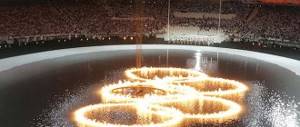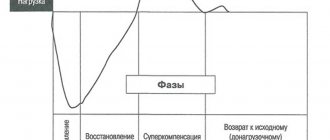Do you have situations when you are downright lazy to train? Apathy, lack of motivation and the only thought in my head is “I wish this would end sooner...”. And in this state it is very difficult to break new records and train effectively. The effectiveness of your training decreases, your progress stops, and you begin to slip back in your results. And this emotionally aggravates the situation...
The phenomenon of stopping progress during training sometimes occurs among cross-country skiers and biathletes. At the same time, their results not only do not improve, but often even become worse. A common cause of this condition is overtraining or, as it is otherwise called, “sports disease.”
From this article you will learn what the concept of “overtraining” means, what causes it, how to overcome it, and what to do for prevention.
What is overtraining
Overtraining occurs in the process of excessive physical activity, which occurs for a long time, as a result of which the body becomes overstrained, weak, apathetic, does not have time to recover and cannot be fully loaded.
Lack of rest between workouts, and subsequently stressful situations, hormonal reasons can lead to general malaise, loss of vitality and motivation to train.
The primary cause of overtraining is physical overexertion, after which psychological symptoms may develop - nervousness, irritability, and insomnia.
Symptoms of Overtraining
Regular implementation of at least one of the above points leads to the following symptoms:
- Insomnia. It seems like you've been running all day long, you're exhausted, it's high time to sleep, but sleep never comes - this is the result of exhaustion of the nervous system as a result of overexertion.
- Decreased immunity. One infectious disease gives way to another. Those who often follow the lives of professional bikini athletes and men's physicists through social networks may notice that during the pre-competition period (under conditions of poor nutrition, intense training and stress) athletes often suffer from colds.
- Psycho-emotional disorders - decreased motivation, nervousness, irritability, a feeling of weakness that occurs immediately after sleep. The desire to play sports, go to training, or do anything at all disappears. In this case, they often complain: “I wake up already tired.”
- Decrease in sports performance. Both progress in training and reduction in working weight disappear. With the usual weight of weights, you cannot perform the required number of repetitions. Psycho-emotional disorders add a decrease in concentration, which often leads to injury and damage.
- Constant muscle pain is a sore throat that lasts for several days, as opposed to the usual one or two.
- Less common signs: loss of appetite, weight loss, rapid pulse, aching joint pain, menstrual irregularities in women .
It is impossible for a doctor to diagnose “overtraining,” since the international classification of diseases (ICD-10) only specifies the concept of “overfatigue.” Overtraining is a consequence of overwork; these concepts are different from each other, although they have a common basis. There are no exact clinical symptoms that can clearly indicate overtraining. A possible increase in resting heart rate by 8-10 beats per minute, tachycardia, arrhythmia or hormonal changes can be a consequence of many other diseases and have nothing to do with the training process.
What does overtraining lead to?
In addition to the main signs described below, muscle strain is a lack of results. Muscles that experience frequent and high stress cannot recover efficiently, which means increasing their mass or losing weight through adipose tissue is impossible.
Despite the goals set, overtraining syndrome must be eradicated immediately and not delayed, otherwise you will get the opposite result. Being under constant stress due to overtraining, in those athletes who gain muscle, catabolism will predominate, which means muscle mass will decrease. The same applies to those who are losing weight, but due to stress, the body can, on the contrary, accumulate fat.
Causes of overwork
Overtraining is often typical for beginners who intensively subject an ill-prepared body to serious physical activity. Also, professionals whose progress is decreasing, and they are trying with all their might to correct the situation by increasing the strength load.
The main reason here is the increased desire to achieve the desired result. It is a misconception that the more a person trains, the greater the effect of the training will be. Fitness and bodybuilding require a careful approach, which should not go beyond the physiology of the athlete.
Before moving on to the symptoms of overtraining, it is necessary to take a closer look at its causes.
The phenomenon of sports addiction
This reason is mainly common among beginners. According to the theory of sports addiction, during and after training, the joy hormone (endorphin) is released into the blood in large quantities, which makes a person satisfied and brings a feeling of joy. Some athletes note a positive state after training, and its absence is observed by a drop in mood and a strong attraction to the gym.
A person tends to engage in training more often, which ultimately leads to overtraining.
Among professional level athletes, sports addiction manifests itself in the form of a desire to achieve greater results by increasing the intensity of training, reducing rest time between training approaches, increasing weight lifting and the frequency of training (more than once a day).
Frequent training to the point of exhaustion leads to a completely different result. Instead of the expected progress, in the form of increased endurance, increased muscle mass and increased athletic performance, everything happens differently. Endurance decreases, performance decreases, muscle tissue is destroyed, and athletic performance decreases.
Following the same program for a long time
When the body receives the same physical load, for example, a constant number of approaches and repetitions, working weights, this also leads to overtraining.
The training program should change every month or every two months. If you constantly follow the same program for a long time, this leads to “emotional burnout,” resulting in physical fatigue, which reduces performance and leads to muscle weakness, as well as myalgia (muscle pain).
Insufficient rest and sleep lead to fatigue
Adequate rest and sleep determine overall well-being and health in general. Even if you don’t devote a lot of time to sports or don’t do it at all, and for example, work up to 10 hours a day, you still need to devote at least 7-8 hours to sleep a day. And if you regularly engage in sports, and intensively, then sleep and rest need to be given even more importance.
On average, the process of muscle recovery takes from 24 hours to several days, and if strength training is excessively intense, then complete recovery may take a whole month. Therefore, it is imperative to give the body the necessary time to rest in order to prevent overwork.
Fatigue as a result of poor nutrition and deficiency of nutrients
The occurrence of overtraining is also characterized by a low caloric content of the daily diet and a deficiency of macro- and microelements. When the body does not receive enough nutritional components for normal functioning, the process of catabolism occurs, which prevails over anabolism. That is, the synthesis of nutrients decreases, and their destruction increases.
In this case, not only muscle tissue is damaged, but also the cardiovascular system. Therefore, a clear deficiency of proteins, carbohydrates and fats, as well as vitamins and minerals, can take you out of training for a long time, up to several months.
Stress at work and at home, decreased immunity
Frequent stressful situations and painful conditions also contribute to overtraining of the body. During periods of stress and reduced immunity, the level of cortisol (stress hormone) increases in the blood. It is this hormone that promotes catabolic processes in the body. Based on this, we can conclude:
- Unresolved problems at work or in the family constantly force the body into a state of catabolism, that is, destruction, which means the risk of overwork increases.
- In a sick state and a weakened immune system, there is also a high probability of overtraining the body.
During such periods, it is advisable to reduce the activity of training or take a break for 2-3 weeks to give the body a rest and get out of a state of stress. Such a pause in sports will not play a significant role on the result, but it can protect you from the adverse consequences of overtraining.
Knowing the causes of overwork, it is important to become familiar with the signs of this pathological condition.
Symptoms and signs of overtraining
- Constant muscle pain, which can be felt as inflammation, overexertion (krepatura).
- General fatigue of the body, constant weakness, lack of energy.
- Drowsiness during the day, especially in the morning, makes it difficult for the body to awaken, and at night, on the contrary, insomnia appears.
- Muscle contractility deteriorates, meaning it is difficult to perform any number of repetitions with any weight, while feeling muscle weakness and lack of tone.
- The muscles may be stiff, and when you palpate them, you feel hypertonicity and tightness.
- The pulse can increase significantly from any degree of exertion.
- Disorders of the central nervous system: irritability, nervousness, apathy appear.
Tips for Avoiding Overtraining
There are several tips that, if followed, will virtually eliminate any drop in progress. They can be divided into 2 categories, recommending certain behavior in the gym, as well as providing for time outside of training.
Tips for behavior outside the gym
- Organize nutritious meals at least 4 times a day (preferably 5-6, with breaks of 2.5-3 hours)
- Be sure to sleep at least 8 hours without waking up to an alarm clock (you can also take an hour to sleep during the day)
- It is better to include pharmaceutical mineral complexes along with vitamins E and C in your diet.
- Be sure to consume more carbohydrates and proteins, not forgetting about healthy fats
- Relieve stress, for which meditation and yoga are perfect
- Deep muscle massage is beneficial
- Take a contrast shower (30 seconds cold, 1 minute warm), which will improve blood circulation
- Drink more fluids
- Effectively use creatine monohydrate
Tips for behavior in the gym
- You should not combine strength training with active sports (boxing, athletics, sex);
- Perform exercises with the correct technique, if necessary, bring it to perfection.
- Do not change the program for 3-4 months.
- Be sure to change the program when your life circumstances change.
- Set a minimum load threshold that can guarantee progress.
- You should not train one muscle group often (beginners tend to load their chest 2-3 times a week, which must be avoided).
- Stretching the muscles before exercise and cooling down after exercise is a must.
- You shouldn’t look up to someone else in the gym by lifting weights that aren’t your own.
- The more significant the load, the worse the immunity, so you don’t need to constantly work at the limit.
Bodybuilding needs to be taken seriously and constant progress must be made. But the line between active training and overtraining is almost invisible and easy to overcome. If you always work a lot, then there is a risk of harming the body and nullifying all progress. Therefore, it is important to remember the listed symptoms and respond to them in time, gradually achieving your goal.
How to get rid of overtraining syndrome
If symptoms have already appeared and are felt for more than one day, but for quite a long time, measures should be taken.
First, you should take a break from training . Many people are afraid that as soon as they take a break for a week, all the results will disappear. This is not true, if the muscles are not filled with blood, as during strength training, then during rest it does not at all mean that their mass has decreased. Taking a break can only be beneficial.
If the syndrome is felt acutely, fatigue seems to knock you down, then it is better not to experience any stress at all until complete recovery, except for walks in the fresh air. After you feel a surge of strength, you should load up gradually. Train literally at half strength, alternating cardio with light strength training.
A course of general massage will help relieve stress from tired muscles and the nervous system. Massage is a well-known means of quick recovery and relaxation. In addition, massage techniques help relax tight muscles, further improving athletic performance. It’s not for nothing that teams of Olympic champions are always and everywhere accompanied by masseurs.
Another method of recovery is warming up the muscles - sauna and steam bath, but only if there are no inflammatory processes and problems with the cardiovascular system .
Treating Overtraining
It is important to quickly notice the symptoms, because the total time to recover from the condition depends on the duration of the course. It always takes more time to recover from overtraining than the duration of symptoms. Next, you need to independently determine how difficult the situation is. Sometimes the solution will be to completely give up the gym for several weeks, during which you need to reconsider the program and the entire training strategy.
An option would be to study materials on how to create your own training program, as well as search for split training programs, which will save time. After all, problems often lie in the program, when back exercises are performed in a row, and then the arms are loaded. This causes the biceps to work beyond its capacity and enter a state of overtraining.
As soon as the symptoms disappear, you need to return to training with light loads, making gradual progress. If it becomes clear that everything is now normal with the body, you can move on to the strength stage. But what to do if the symptoms are not too obvious and the situation is just beginning to develop?
Then you don’t have to give up training, you just need to increase the amount of rest. For example, if you previously visited the gym every day, then it makes sense to switch to a three-times-a-week schedule. Here, after each day of stress there will be a day of rest. And the intensity of exercises should be reconsidered in the direction of reducing working weights along with the number of approaches (read more about how to choose the number of approaches and repetitions in training).
Of course, in each case there is no need to ignore nutrition. In the process of overtraining, it will definitely need to be made high-calorie. To find out how many calories you need to consume, just multiply your own weight in kilograms by 30. You will get a number indicating the required amount of calories. You need to add 500, or maybe the whole 1000, to it to make the food high-calorie.
Of course, we continue to eat a diet created specifically for bodybuilders. That is, we include a lot of complex carbohydrates in the diet, sometimes feeding the body with simple compounds (often sweets). He does not forget about animal protein, consuming at least 1.6 grams per kilogram of personal weight.
Our website has a large section with nutrition programs compiled by professionals. A filter system, ratings, and the ability to edit to suit your needs! Go to the nutrition section and choose the program for yourself!
In a state of overtraining, you should not “hang out” in clubs at night; quality sleep, lasting at least 8 hours, is important here. Sometimes, depending on how you feel, you can even bring it up to 15 hours, because lack of sleep is worse than malnutrition.
How to Avoid Overtraining
- Use frequency: perform a light load one week, and get closer to your maximum the next. If you're not training for a competition, this method will help you stay in shape without overtraining.
- After exercise, stretch your muscles , this will maintain their elasticity and speed up recovery. Read more about post-workout stretching →
- Don't train every day , take at least one day of rest between exercises. The average duration of training should be about one hour, but never two or more.
- Eat well , consume amino acid complexes, foods rich in proteins, carbohydrates, and fatty acids. Take vitamins and minerals.
- Sleep is the key to success ; lack of rest leads to overwork and the inability to recover from stress. Sleep also has a beneficial effect on the nervous and endocrine systems.
Recovery from Overtraining
First of all, the treatment for overtraining consists of physical rest and rest:
- Break from training for 4-7 days
- Sleep at least 8 hours a day
- Nutritious food
- Massage and bath
- Take a break from sports, watch movies, read books, do family activities
- Protect yourself from stress, don't think about being out of shape
After rest, start training every other day in an easy mode. Don’t force your form in the desire to quickly return to your previous level. It will take about 2 times more time than you spent on vacation. Roughly speaking, after 1 week of rest, you need at least 2 weeks to get back into shape. If the training began to go well, the recovery was successful.
If the signs of overtraining have not disappeared, contact a sports doctor, undergo examinations and continue recovery.
OVERTRAINING AND OVERSTRESSING
In the process of regular training, the functional capabilities of the athlete’s body expand, and a gradual formation and development of fitness occurs. The development of fitness, a state determined by biological, pedagogical and psychological factors, is based on the process of adaptation of the body to the action of repeatedly repeated stimuli - physical and mental stress. The level of training determines the athlete’s well-being, his performance, reaction to load, and readiness to achieve high results in his chosen sport. The rate of increase in fitness and its manifestation are determined by the direction of the training process, the characteristics of the sport, the age and initial level of preparedness of the athlete. The highest level of functional readiness (the so-called “sports form”) is characterized by the maximum indicators of sports activity for a given athlete.
If the training is structured incorrectly and the load does not correspond to the athlete’s capabilities (especially against the background of past illnesses, irrational regimen and other factors that weaken the body), the normal course of development of training is disrupted, the athlete’s well-being and performance deteriorate, various pre- and pathological conditions develop, among which the coach needs be able to identify, first of all, overfatigue, overtraining and overexertion.
Overfatigue occurs when the phenomena of fatigue are layered, when the athlete’s body does not recover from one activity or competition to another for a certain time. Overwork manifests itself in a longer-than-usual persistence of a feeling of fatigue after exercise, deterioration in well-being, sleep, increased fatigue, and unstable mood. Sports performance may generally remain without significant changes or decrease slightly. But difficulties in developing new motor skills and solving complex tactical problems become noticeable, and technical defects appear. Objectively, it is possible to determine a decrease in strength indicators, deterioration in coordination, and reaction to stress (extension of the recovery period). As a rule, there are no dysfunctions of organs and systems; in some cases, heart rhythm disturbances and blood pressure fluctuations, pain in the right hypochondrium during exercise, and increased muscle tone occur. To eliminate overfatigue, it is usually enough to make short-term (over several days) adjustments to the training: introduce additional days of rest, reduce the load, change external conditions, exclude competitions, diversify the rest, strengthen recovery measures (vitaminization, good nutrition, massage, hydrotherapy, etc.) etc.), normalize sleep and routine.
Overfatigue is a borderline state between the physiological phenomena of fatigue caused by physical activity and pathology. If the necessary measures are not taken in time, overwork can turn into overtraining.
Overtraining is a pathological condition, a manifestation of disadaptation, a violation of the level of functional readiness achieved during training, regulation of the activity of body systems, the optimal relationship between the cerebral cortex and the underlying parts of the nervous system, the motor system and internal organs. Overtraining is based on overstrain of cortical processes, and therefore the leading signs of this condition are changes in the central nervous system that occur like neuroses. Changes in the endocrine sphere, mainly the adrenal cortex and pituitary gland, also play a major role. Secondarily, due to dysregulation, changes in the functions of various organs and systems may occur.
Leading signs of overtraining: deterioration in well-being, increased fatigue, unstable mood (apathy or, conversely, irritability, aggressiveness), sleep and appetite disturbances, discomfort in the heart, headaches, palpitations, heaviness in the legs, in the liver, etc., decreased performance and athletic performance, loss of interest (sometimes even aversion) to training and competitions, lack of self-confidence, suspicion, obsessive states. In a state of overtraining, motor skills and habitual movement techniques, mutual understanding with partners are disrupted, body weight and muscle strength decrease; Sexual function and, in women, the menstrual cycle may be impaired; immunity, resistance to diseases, injuries, and various stress factors decrease; There is a deterioration in the performance of coordination and vestibular tests, slowdown and instability of motor reactions, and increased sweating.
The economy of blood circulation and respiration in a state of muscular rest, characteristic of a trained athlete, worsens. Heart rhythm disturbances are common - tachycardia or, conversely, severe bradycardia, severe sinus arrhythmia, extrasystole. Blood pressure is unstable: there is either an increase (mainly systolic) or a tendency to severe hypotension. The liver may become enlarged, and sometimes there is pain in the right hypochondrium during exercise. Changes in metabolism and energy are observed: increased basal metabolism, vitamin deficiency, decreased blood sugar levels, disturbances in thermoregulation, adrenal and thyroid function, and oxidative processes.
The body's response to physical activity changes significantly: it becomes more tense, with discordant shifts in various indicators, and atypical reactions appear. Physical performance decreases, the oxygen cost of the load increases, repayment of the oxygen debt becomes more difficult, the accumulation of lactic acid in the blood increases, and recovery slows down.
The degree and nature of changes in the athlete’s general condition and various body functions are determined by his individual characteristics and the stage of overtraining. S.P. Letunov identified 3 stages of overtraining. The first stage - the initial phenomena, essentially differ little from overwork. The athlete most often has no complaints.
Due to the vagueness of complaints and the clinical picture (especially in cases where there is no pronounced decrease in performance), this stage of overtraining is often not diagnosed, which entails a transition to the more severe second stage. The second stage is characterized by a gradual increase in disturbances.
In the third stage of overtraining, which is now extremely rare due to improved medical and pedagogical control, a picture of pronounced neurosis (like neurasthenia and psychasthenia) is observed with secondary changes in various physiological systems of the body, a long-term and sharp decrease in sports performance.
The first stage of overtraining, if identified and treated in a timely manner, is completely reversible; with pronounced second and especially third stages, long-term consequences remain, and sometimes restoration of sports performance and results does not occur.
Treatment is aimed primarily at increasing the overall stability of the body and restoring the functional state of the central nervous system by normalizing the athlete’s general routine and sleep, nutritious balanced nutrition and vitamin supplementation (especially groups B, C, E), eliminating any stress factors, using various physical factors (ultraviolet irradiation, aeroionization, coniferous, pearl, sodium chloride baths, various showers, galvanization, electrophoresis, massage, etc.) and medicines (sedatives, mild cardiac, iron, calcium preparations), and in severe stages - some hormones. If the function of any system or organ is impaired, appropriate corrective treatment is carried out. To normalize the psycho-emotional status, psychotherapy, autogenic training, etc. are used. The correct approach of the coach and team, which spares the psyche of the sick athlete, is very important. Interesting recreation and distractions are important.
The correct motor mode is of decisive importance in the treatment of overtraining and restoration of sports performance. During the first stage, it is enough to reduce the number of classes for 2-4 weeks, limit speed and strength loads and technical exercises that require a lot of nervous tension, increase the intervals between classes and exercises, make wider use of non-specific loads and switching, change external conditions (conduct classes in the forest, park, on the river bank, in cool weather). Swimming, walking and recreational jogging, skiing and skating, etc. are useful. Participation in competitions during this period is excluded.
As the athlete's condition and mood improve, as well as the indicators of dynamic observations and response to physical activity, the training regimen gradually approaches the usual one. Participation in competitions is allowed only after restoration of the functional state.
In the second stage of overtraining, the athlete needs a complete rest from training for 1-2 weeks; after this, for 1-2 weeks it is allowed to use only non-specific loads that do not cause pronounced fatigue: walks, morning exercises, alternating running, swimming, skiing, outdoor and sports games. Then the motor mode is gradually expanded, increasing the proportion of exercises of the chosen sport, their volume and intensity. It is allowed to switch to a normal training regime with possible participation in competitions (subject to the normalization of the athlete’s general condition and his adaptation to physical activity) no earlier than after 1.5-2 months.
At the third stage of overtraining, complete rest is needed for 3-4 weeks (only small loads of a general developmental nature are possible, such as physical therapy for neuroses). Resumption of training is allowed no earlier than after 1.5-2 months, participation in competitions - after 2-3 months.
Treatment and rehabilitation in severe stages of overtraining should be carried out in sports hospitals and rehabilitation centers.
A properly organized training process allows you to completely eliminate the development of overtraining. However, to do this, you need to clearly understand the reasons for overtraining. They can be combined into the following groups:
a) deviations in the athlete’s health;
b) violation of the general regime;
c) incorrect training regimen and methodology;
d) unfavorable training conditions;
e) some individual characteristics of the athlete. Training against the background of illnesses and injuries is accompanied by
greater than in a healthy state, stress on all body functions. When the body is presented with increased demands associated with physical activity, the compensation sufficient for its functioning under normal conditions is disrupted, the body’s immunity and stability are reduced, regulation deteriorates, nervous tension increases, adaptation is disrupted, which is the basis of overtraining. Especially dangerous in this regard are foci of chronic infection (mainly in the oral cavity, tonsils, biliary tract), latent diseases of various organs and systems. Therefore, before starting regular sports, and then at least 1-2 times a year, the athlete must undergo a comprehensive medical examination, and the coach must take into account the results of this examination when planning the educational and training process and deciding on admission to competitions. If signs of illness appear, training should be stopped immediately and the athlete should be referred to a doctor. The athlete's training and general regimen, the nature of treatment, the timing of resumption of training and admission to competitions are determined by the doctor, taking into account the nature and course of the disease and the condition of the patient. The trainer must strictly follow all doctor’s prescriptions and recommendations. You cannot arbitrarily shorten the recovery period after illnesses and injuries, because this (in addition to the immediate danger to health) increases nervous tension, leading to overtraining.
The desire to achieve high results in case of health problems, participation in training and competitions despite a doctor’s prohibition, and neglect of medical recommendations are unacceptable. The coach is responsible for this. Together with the doctor, he must organize medical care and treatment and preventive work in such a way as to promptly identify and eliminate all (even minor) manifestations of diseases and injuries, and ensure their effective prevention.
Overstrain of nervous processes and disruption of adaptation are also facilitated by violations of the athlete’s general regime: irrational combination of workload and study with training loads, nervous overload and troubles (work, family, household), psycho-emotional stress, unfavorable psychological climate and poor relationships in the sports team, inadequate reaction to failures and troubles, drinking alcohol and smoking, poor sleep, poor diet, frequent and excessive weight loss, failure to comply with basic rules of hygiene, etc. Therefore, the coach must daily monitor not only the progress of the training, but also the entire lifestyle of the athlete and be able to subtly and tactfully intervene in it if necessary.
Of the violations of the training regime and methodology that contribute to the development of overtraining, the most important are: irregular and forced training, inconsistency of loads and requirements with the athlete’s level of preparedness, insufficient intervals between classes, too frequent competitions, highly specialized monotonous training, lack of proper rest and recovery, joint training and competitions between people with a large difference in age and level of preparedness.
Training and especially competitions in difficult environmental conditions (high temperature and humidity, lack of oxygen, atmospheric pollution, etc.) without sufficient preliminary preparation are associated with increased demands on the body and slower recovery. Under these conditions, overtraining is more likely to develop.
The individual characteristics of the athlete’s nervous system and personality are of considerable importance. Thus, breakdowns and overtraining more often occur in excitable individuals with an unstable and weakened nervous system, during puberty and the onset of age-related decline in functions, in individuals with a genetically determined slow course of recovery processes, etc. Therefore, the same load, the same The training regimen can cause different changes in the body of different athletes. The same approach to determining the load regime can lead to increased training in some athletes and to overtraining and decreased performance in others.
Overexertion can be acute (see 9.4) and chronic, which occurs as a result of the use at some stage of training of loads that do not correspond to the athlete’s functional capabilities, and various violations of the training regime and methodology.
In contrast to overtraining, chronic overexertion is manifested by changes in individual organs and systems, while the athlete’s general condition and performance may remain unchanged for a long time. The most common is chronic physical overstrain of the heart. A.G. Dembo designates it as myocardial dystrophy due to chronic overexertion. This type of dystrophy differs from that described (see Chapter II). It is based on metabolic disorders, increased permeability of cell membranes, increased content of catecholamines, and changes in ionic balance in myocytes. Only in advanced stages, apparently, can degenerative changes appear.
At the beginning of the development of chronic overexertion, only changes in the final part of the Q-T complex are noted. ECG - flattening and inversion of T waves in different leads, which is associated with the predominant localization of the process (L. A. Butchenko). With an in-depth study, it is often possible to identify a slight decrease in myocardial contractility, deterioration in adaptation to physical activity. Dynamic electrocardiographic studies, determination of performance, exercise tests and pharmacological tests (potassium test and beta-blocker test) are very important for diagnosis.
If ECG changes occur, adjustments should be made to the training regimen, despite maintaining performance and the absence of complaints. If this is not done, an increase in phenomena, irreversible changes (foci of necrosis, cardiosclerosis and scar changes), and a long-term decrease in sports performance are possible. The doctor's recommendations are mandatory for the trainer. Treatment (potassium supplements, beta blockers, inosine, panangin, riboxin, etc.) is aimed at increasing the general, nonspecific resistance of the body and eliminating dystrophic changes. The timing of cessation of training, changes in its mode and methodology are determined by the doctor depending on the stage of overexertion, the condition and qualifications of the athlete, the type of sport, etc. In case of irreversible changes in the ECG, training aimed at achieving a high result is contraindicated. After normalization of the ECG, training is carried out without restrictions.
In case of chronic myocardial overstrain, it should be borne in mind that such ECG changes can also occur due to other reasons - pronounced vagotonia and myocardial hypertrophy, coronary circulation disorders, cardiosclerosis, physiological characteristics of the heart of children and adolescents. All this requires a careful differential diagnosis carried out by a doctor.
Chronic overstrain can also affect other vital organs (kidneys, liver, muscles, etc.) - It is accompanied by certain changes in medical examination parameters.
From the above it follows that the best prevention of violations of the functional state of the athlete’s body is correct selection, rational training regimen and methodology, full recovery, individual approach, regular medical and pedagogical control.
To prevent overtraining and overexertion, the coach needs to know their causes and signs in order to promptly refer the athlete to a doctor and make adjustments to training, correctly use means of restoring performance and increasing the body’s nonspecific stability.
Causes of overtraining
In addition to long or too frequent intense training, causes of overtraining can include:
— Insufficient water consumption. For this reason, toxins and waste accumulate in the body, excess energy is consumed, immunity decreases and, as a result, the body becomes overtrained.
- Poor nutrition. Lack of food, as well as its excess, slow down recovery - the body needs “fuel”, but in a reasonable amount. A small amount of protein in the diet does not allow muscles to recover, since protein is the main building material for muscle fibers. And carbohydrate hunger destroys the nervous system. So it’s better to stick to a balanced diet rather than go to extremes.
- Lack of sleep. If you sleep less than 6 hours, the body simply does not have time to recover, fatigue accumulates and overtraining occurs. This algorithm works the same for women and men, regardless of their level of physical fitness.
- Stress. A bad mood and an unstable emotional state are a sign of psychological weakening of the body, which can subsequently also affect the physical state.
— Infectious or exacerbated chronic diseases. Even the first manifestation of symptoms of the disease is a signal to stop exercising. During illness, all the body’s forces are spent fighting infection, and there is simply no energy left for training.
Here you will find an effective set of exercises from one of the best fitness trainers in the world - Jim Barcena.
Stages and degrees
Overtraining (symptoms, causes and consequences) is a topic of interest not only to professional athletes, but also to simply people actively involved in sports. Because it is amateur athletes who do not have specialists nearby in nutrition, regeneration and drawing up the correct training regimen, who are susceptible to overtraining.
They often practice on their own and operate under the motto “the more the merrier.” In particular, this applies to those involved in CrossFit.
Stages:
1. Neurotic. This stage is often confused with ordinary fatigue, as it is usually asymptomatic. A training person may occasionally complain of poor sleep. The first stage is characterized by a cessation of growth in athletic performance.
Training during the neurotic stage can be continued, but it is recommended to reduce the total volume of load and eliminate long and technically complex exercises. If you feel better, you can gradually return to regular workouts.
2. Neurodystrophic. In the second stage, the athlete already has a lot of complaints (general fatigue, loss of interest in training, decreased body weight). Recovery after training is slower. Training results decrease. The positive attitude towards exercise disappears, motivation is lost.
It is advised to replace training with active rest for a couple of weeks. Then gradually start training. Classes need to be planned so that within 1-2 months you can reach your normal training regimen.
3. Profound pathological changes. The most severe stage of overtraining. The general condition of the body worsens, the disorders described in the second stage become more pronounced. In the third stage, there may be a ban on training for up to six months, complete rest is prescribed for the first two weeks and active rest for the next 1-2 months.
The third stage is considered an advanced variant and does not occur often. If in the first two stages a person can solve the problem on his own, then at this stage rehabilitation must necessarily be accompanied by the supervision of a specialist. Inpatient treatment is prescribed and specialized therapeutic procedures are carried out.
It should be noted that overtraining in people who have just started playing sports is confused with addiction and adaptation of the body to new conditions. Although, after the first classes, when the adaptation process takes place, signs similar to the first stage of overtraining appear: muscle pain, a new diet, problems with concentration and sleep.
After a week of regular training, these negative aspects will pass, as the body gets used to the new loads and endurance develops over time.
If a novice athlete wants to immediately achieve quick and great results, the so-called preliminary stage of overtraining may occur - overexertion.
The body is not yet accustomed to training, and it takes longer to recover compared to a person who has been exercising for a long time. Several intense workouts in a row, little sleep, and overexertion sets in. But it goes away quickly if you plan your classes correctly.
Possible complications
Symptoms of overtraining are not immediately noticed. But if the body’s signals are nevertheless noticed, measures should be taken to cope with the problem that has arisen. If this is not done, both minor and quite severe complications are possible.
Negative consequences of overtraining:
| Gaining excess weight | Although an overweight person is advised to undergo fairly intense physical activity to solve the problem, the result may be the opposite. This is due to several factors.
|
| Overtraining syndrome | Intense physical activity with a lack of rest can cause chronic stress. Which, in turn, is associated with adrenal problems. The adrenal glands become exhausted and reduce the production of hormones that are important and necessary for the body. All this leads to overtraining syndrome - loss of appetite, chronic fatigue, and violation of the regime. |
| Women's problems | The body of any woman is at risk if she trains intensively. Even non-professional athletes, without controlling physical activity and rest, can encounter problems such as:
|
| Decreased immunity | The immune system suffers greatly from constant and excessive physical activity without rest. When problems with hormonal levels, pain in muscles and joints are added to this, the body is at risk. Any infection or inflammation can increase and develop into a serious illness. |
| Heart problems | Frequent endurance exercise over a long period of time can lead to unpleasant and dangerous consequences such as arrhythmia, thickening of the heart valves, changes in blood pressure, and damage to arterial walls. |
| Depression and mental suffering | In the long term, overtraining burdens the entire body, and therefore the mental state. Lack of success in sports and physical discomfort contribute to the development of depression and personality changes. |
Overtraining and its symptoms can have a fairly negative impact on the quality of life of an active person. To avoid this, you need to carefully consider the training process and purposefully give the body time to regenerate.
Without sufficient recovery time, progress will not be made and there will be no positive emotions from the exercise.











